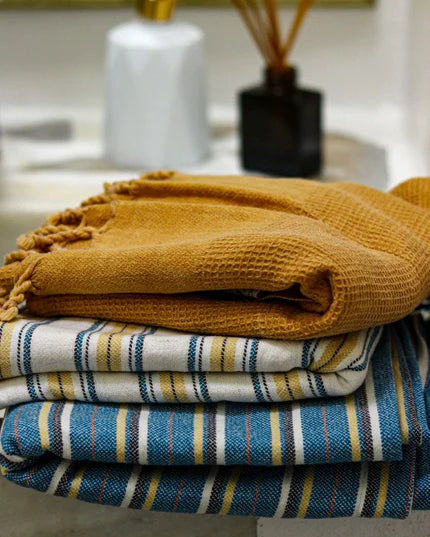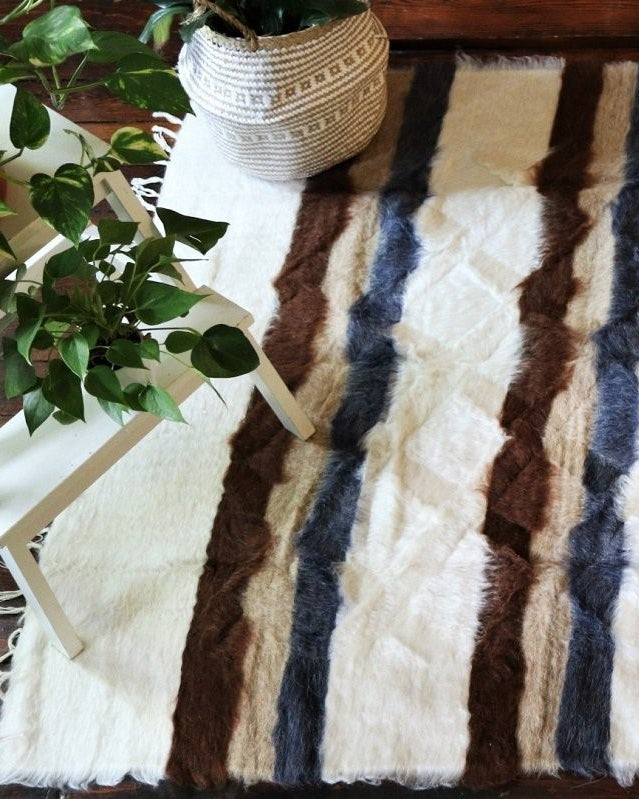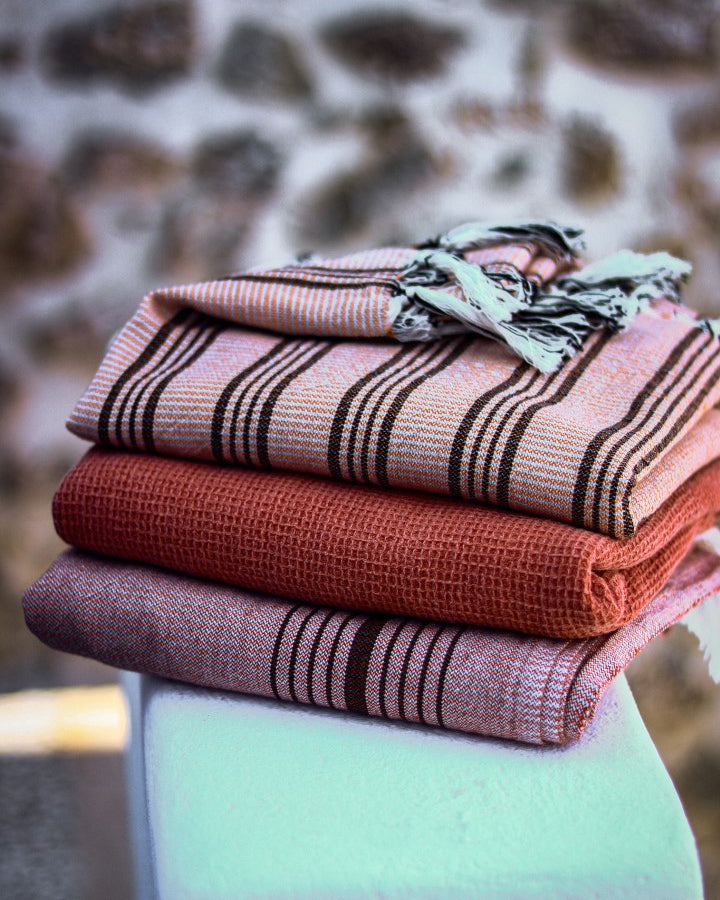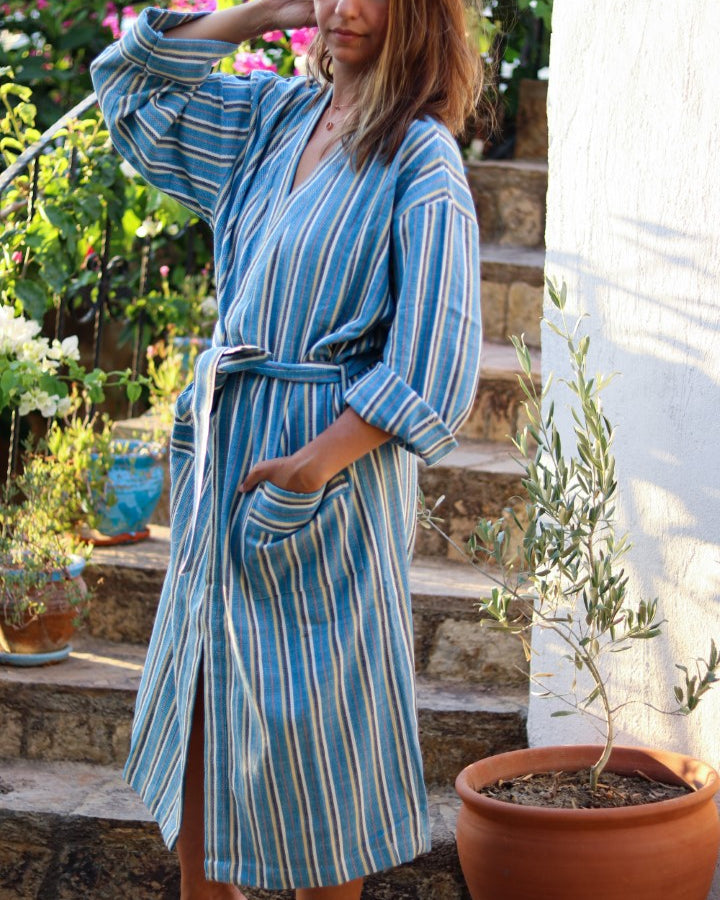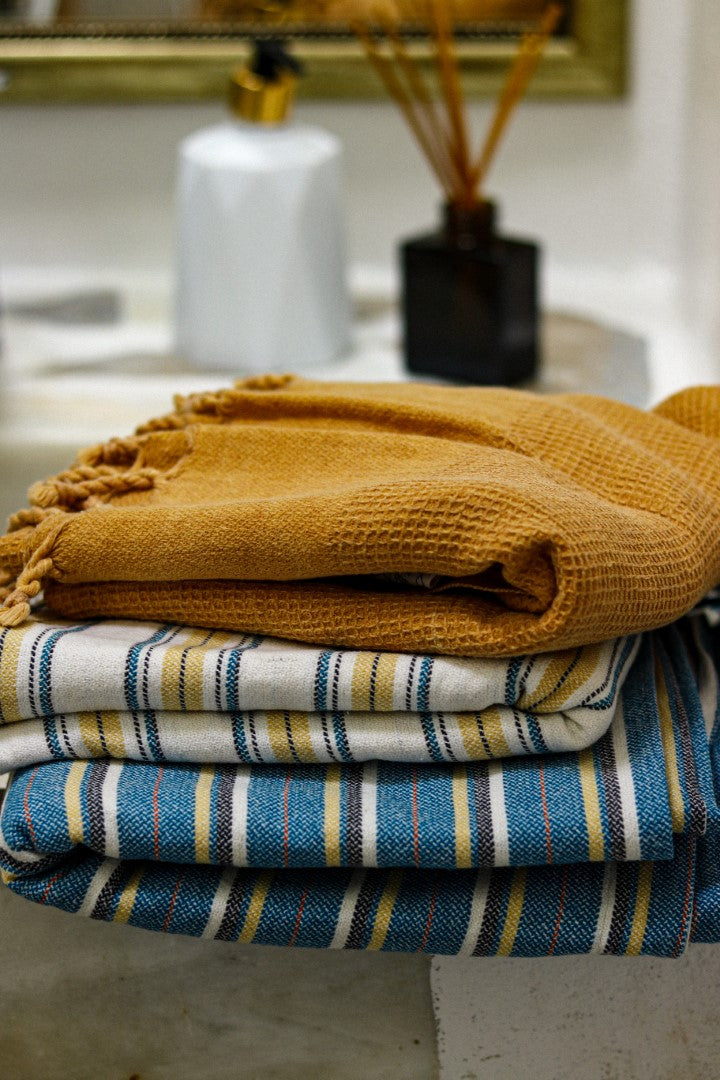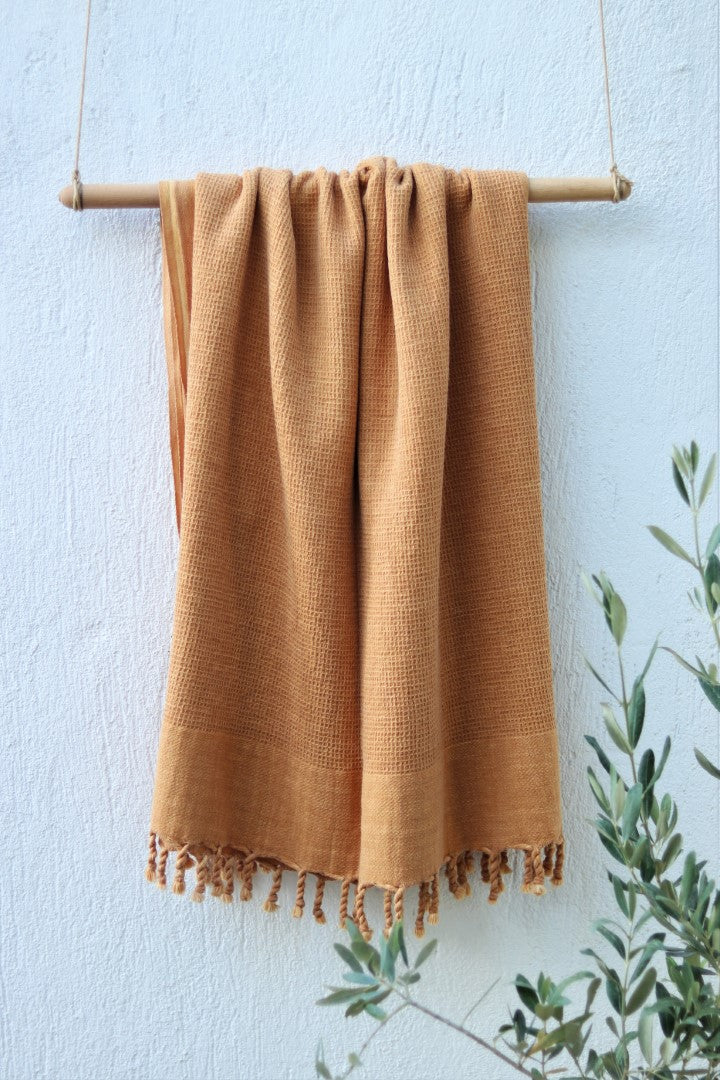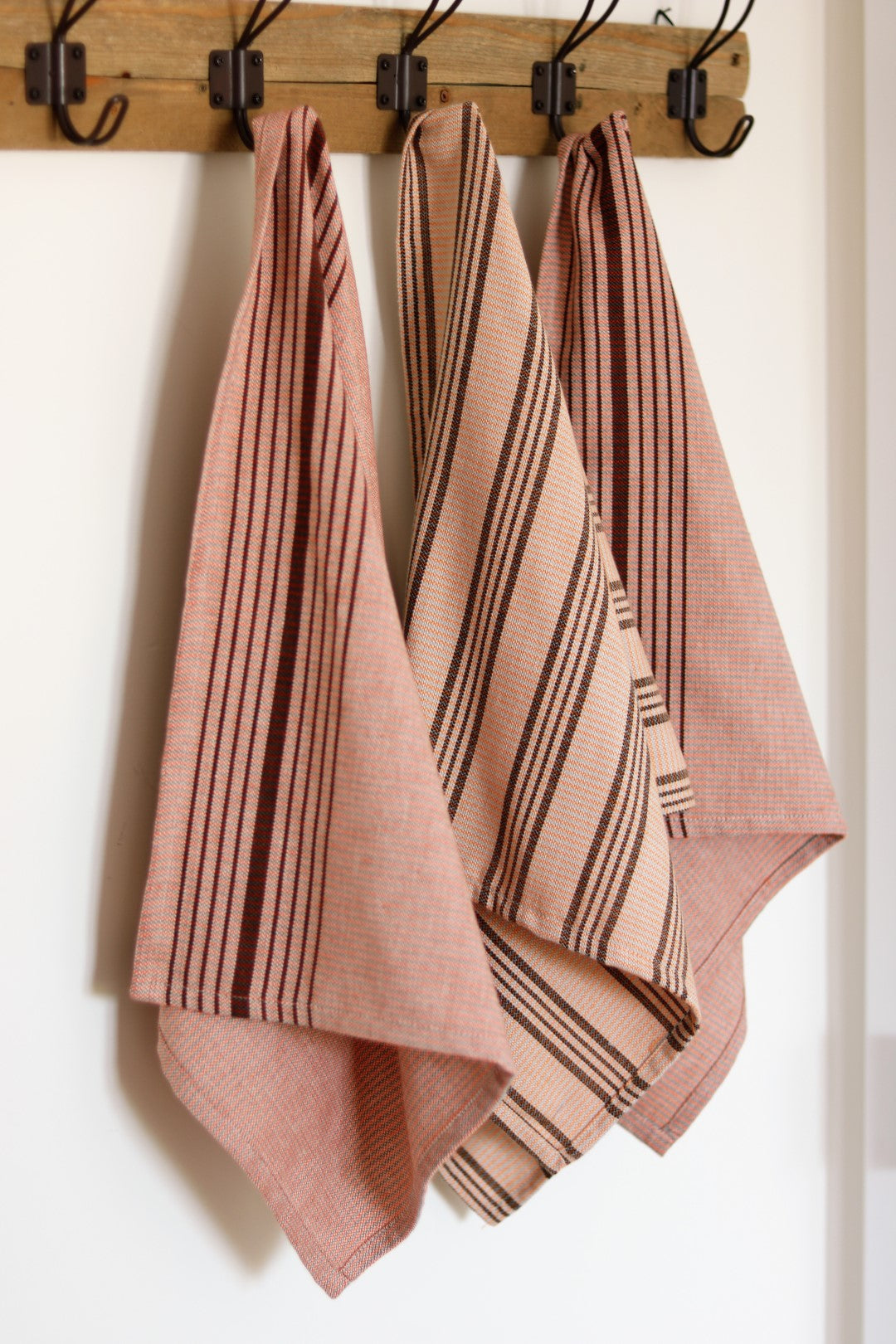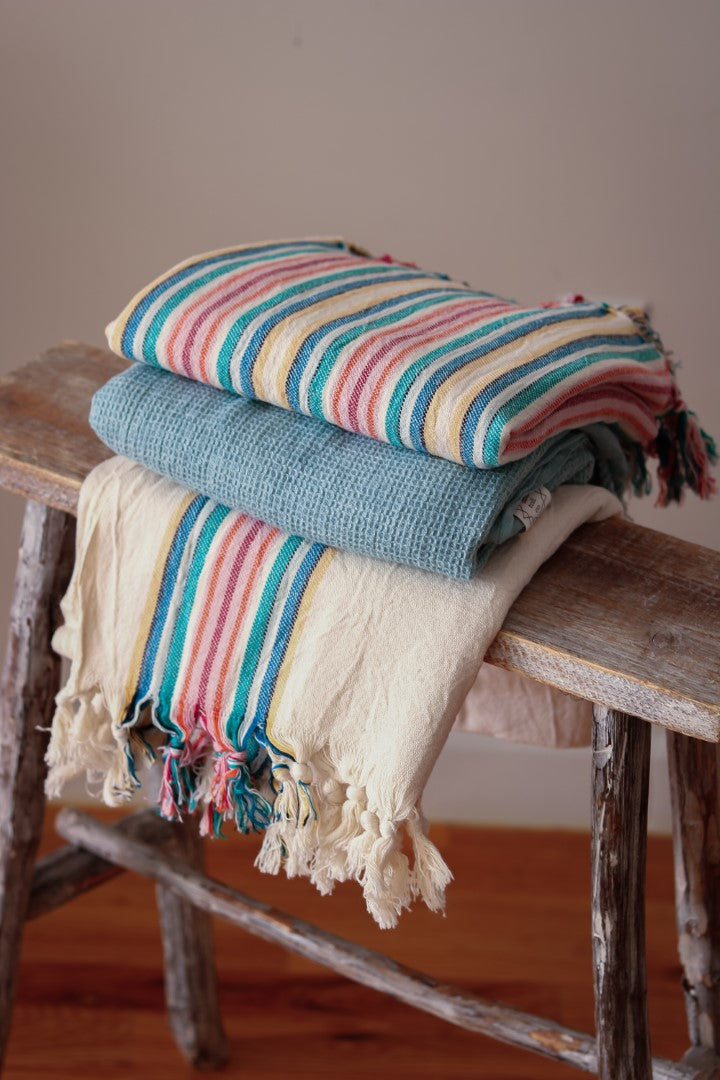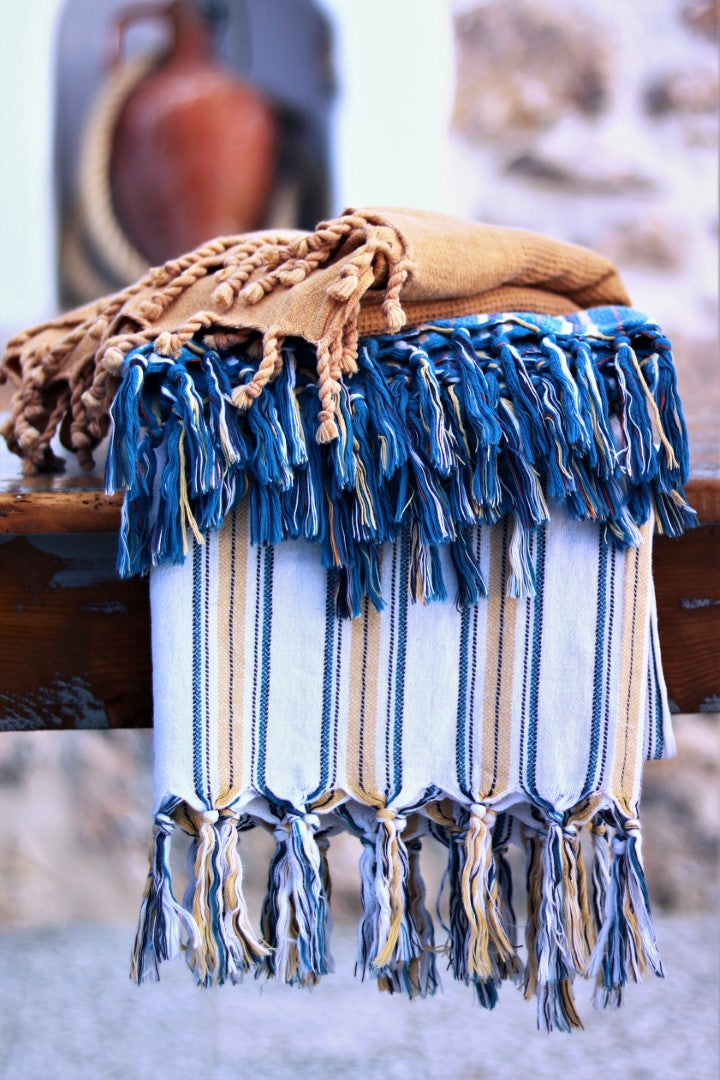At its heart, the difference between organic and conventional cotton comes down to farming. Organic cotton farming works with nature, skipping the synthetic pesticides, fertilizers, and GMOs. On the other hand, conventional cotton relies on a chemical-heavy approach to fight off pests and pump up the yield.
The Core Differences in Cotton Production
When you pick up a simple cotton t-shirt, you’re holding the end result of a complex agricultural story. The split between organic and conventional isn't just about the fabric itself; it's a tale of two completely different farming philosophies, each with major impacts on the planet, the farmers, and even us.
There's a reason conventional cotton has been dubbed one of the "dirtiest crops." Its production is famously reliant on synthetic inputs. Think about this: while it only takes up 2.5% of the world's farmland, it's responsible for a huge slice of the global pesticide and insecticide use. This reliance on chemicals can strip the soil of its nutrients, pollute local water supplies, and create health hazards for farmworkers.
Organic cotton farming, by contrast, is designed to be a regenerative system. It all starts with non-genetically modified seeds planted in healthy soil built up with natural techniques like crop rotation and composting. Instead of spraying chemicals, farmers introduce beneficial insects and other natural deterrents to keep pests in check. The whole system is about creating a balanced, resilient ecosystem that actually boosts biodiversity and protects the environment.
This infographic does a great job of showing the stark contrast between the two farming systems.
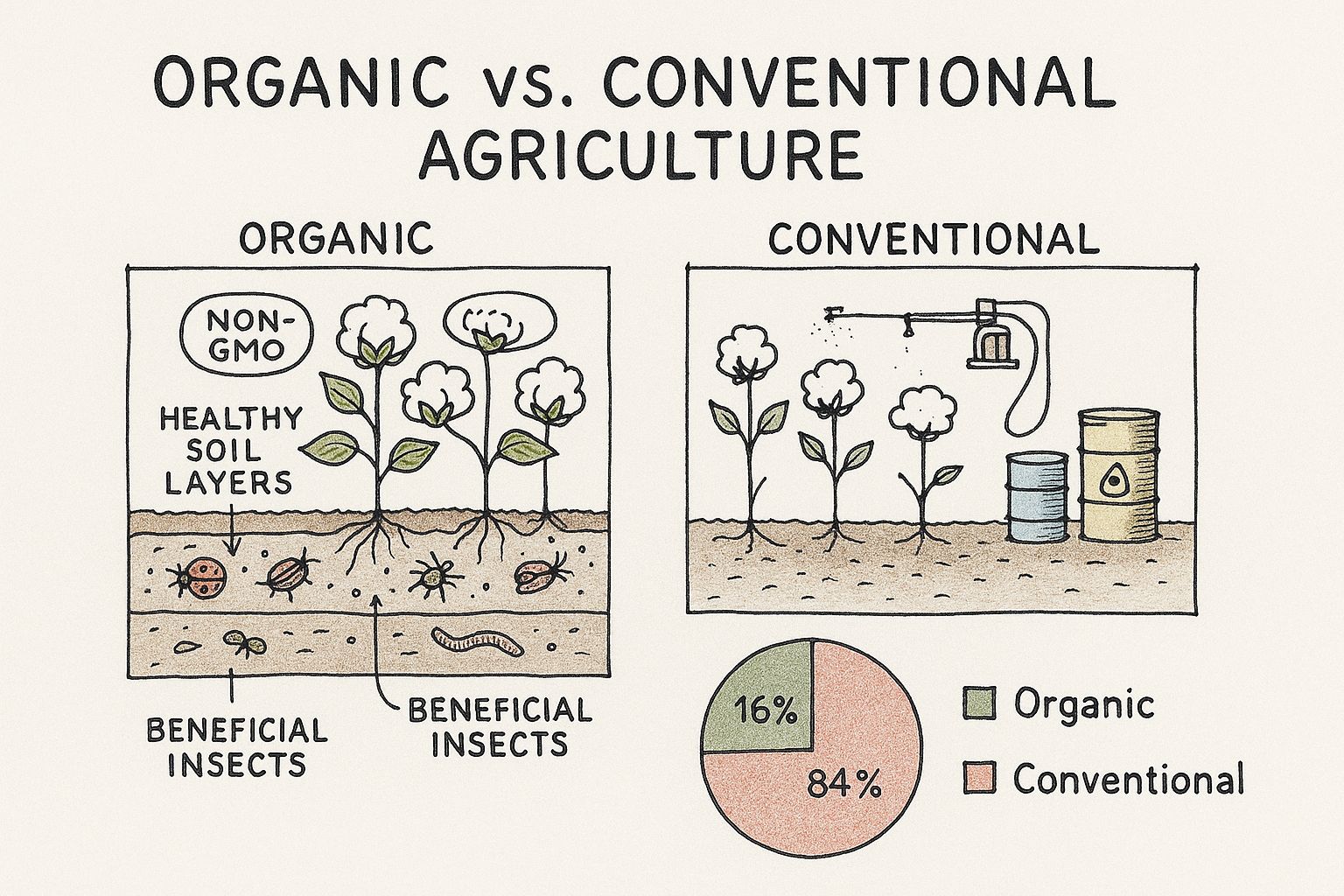
You can really see the difference. Organic fields look alive, with rich soil, while conventional fields often appear sterile from all the chemical intervention. These foundational differences are what lead to the massive gaps in water usage, carbon footprint, and overall sustainability we'll explore.
A High-Level Comparison
To quickly get a handle on the organic vs. conventional cotton debate, it's helpful to see the main attributes lined up against each other. The table below gives you a clean, high-level summary of the most critical distinctions.
This quick-glance table captures the fundamental differences in a nutshell.
The choice between organic and conventional cotton extends far beyond personal preference. It reflects a decision about the kind of agricultural and economic systems we support—one that depletes natural resources or one that regenerates them for future generations.
Now, let's break down the key differences in a bit more detail.
Key Differences: Organic Cotton vs Conventional Cotton
| Attribute | Organic Cotton | Conventional Cotton |
|---|---|---|
| Seeds | Natural, non-GMO seeds | Often genetically modified (GMO) for pest resistance and higher yield |
| Pesticides | Prohibited; natural methods like beneficial insects are used | Heavy use of synthetic insecticides and pesticides |
| Fertilizers | Natural fertilizers like compost and manure | Synthetic, chemical-based fertilizers |
| Water Use | Significantly lower; healthy soil retains more water | High water consumption, often requiring extensive irrigation |
| Soil Health | Enhanced through crop rotation and natural practices | Degraded over time due to chemical use and monoculture |
| Weed Control | Manual or mechanical weeding | Chemical herbicides |
| Certifications | Requires strict certifications like GOTS (Global Organic Textile Standard) | Generally lacks comprehensive environmental or social certifications |
| Cost | Typically higher due to farming practices and certification costs | Lower due to subsidies, higher yields, and established supply chains |
This comparison really highlights that the "organic" label is much more than a marketing buzzword. It represents a real commitment to a healthier planet and safer products from the ground up.
Comparing Cultivation from Seed to Harvest
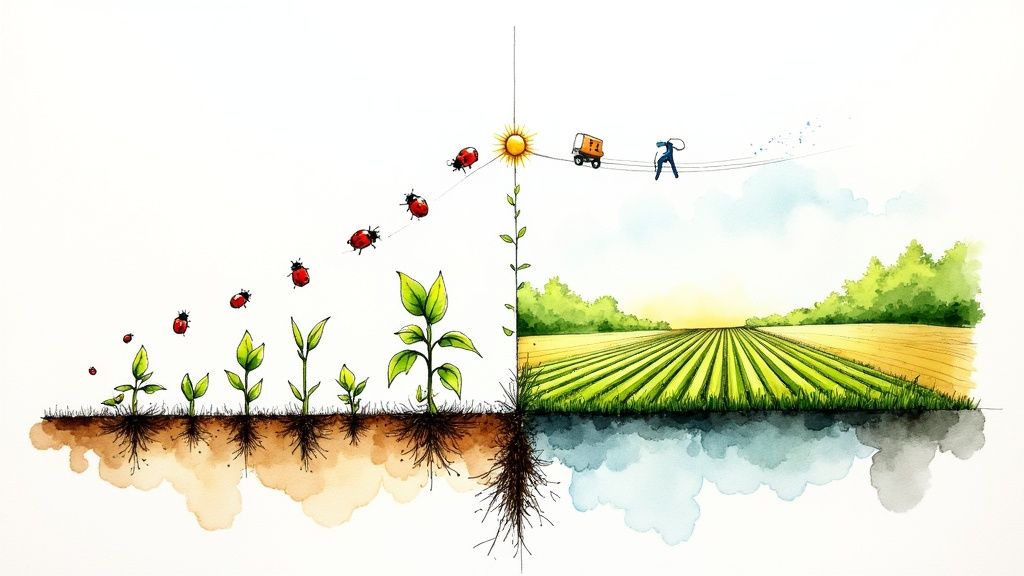
The real story behind the organic vs. conventional cotton debate starts in the field. To truly grasp the difference, you have to look at the entire journey, from the moment a seed is planted to the day the cotton is harvested. These two approaches couldn't be more different, diverging right from the start and following separate paths for soil prep, pest control, and harvesting.
The conventional cotton story almost always begins in a lab. The vast majority of it is grown from genetically modified (GM) seeds, specifically engineered to either tolerate powerful herbicides or produce their own internal pesticides. This high-tech approach is designed for massive, single-crop farms where pushing for maximum yield is the name of the game.
Organic cotton, however, starts with natural, untreated, non-GMO seeds. This isn't just a small detail; it's a foundational choice that shapes the entire farming philosophy. The goal isn't just output but building a resilient, balanced agricultural system, and that begins with the integrity of the seed itself.
Soil Preparation and Nurturing
How each system treats the soil is a night-and-day difference. In conventional farming, the ground is often viewed as little more than a placeholder to prop up plants. It's force-fed with synthetic, chemical-based fertilizers to spur growth.
These chemical fertilizers deliver a jolt of nutrients, but they do nothing to build up the soil for the long haul. Over time, this method degrades the soil, stripping away organic matter and killing off the microbial life that keeps it healthy. You end up with depleted, lifeless dirt that needs more and more chemical inputs just to function.
Organic farming treats soil as a living, breathing ecosystem. Instead of synthetic fertilizers, farmers rely on natural methods like composting, animal manure, and planting cover crops to build rich, fertile earth. The focus is on feeding the soil, not just the plant.
A core principle of organic agriculture is building healthy soil that acts like a sponge. This rich, organic matter retains water more effectively, supports a diverse biome of beneficial organisms, and naturally suppresses some diseases, reducing the need for external inputs.
This dedication to soil health has massive ripple effects. For one, healthy soil needs far less water—a critical advantage when you consider that conventional cotton is one of the thirstiest crops on the planet.
The Battle Against Weeds and Pests
Nowhere is the contrast more stark than in the fight against pests and weeds. Conventional cotton farming declares all-out chemical warfare.
It's a shocking statistic: cotton is grown on just 2.5% of the world's cultivated land, yet it consumes a staggering 16% of all insecticides sold globally. Conventional fields are routinely doused with potent pesticides and herbicides to wipe out any competition, effectively sterilizing the environment.
This reliance on chemicals has serious consequences. It kills beneficial insects, poisons local waterways through runoff, and exposes farmworkers to a constant barrage of toxic substances.
Organic farmers, on the other hand, manage pests by working with nature, not against it. Their toolkit looks very different:
- Crop Rotation: By planting different crops in the field from one season to the next, they naturally disrupt the life cycles of pests that target cotton.
- Beneficial Insects: Farmers deliberately introduce and encourage populations of natural predators, like ladybugs and lacewings, to keep pest numbers in check.
- Manual Weeding: Instead of herbicides, weeds are controlled the old-fashioned way—through physical removal with hoes or by hand.
This integrated approach creates a balanced farm ecosystem where no single pest can get the upper hand. While it's definitely more labor-intensive, it's a profoundly sustainable method that protects both biodiversity and human health. This is where the organic cotton vs. conventional cotton divide is perhaps most clear.
Analyzing the Environmental Footprint of Cotton
When you put organic and conventional cotton side-by-side, the most dramatic difference lies in their environmental impact. Each fiber's journey, from the moment a seed is planted to the final fabric, leaves a unique mark on the planet. The two biggest points of departure? Water consumption and chemical pollution.
Conventional cotton has earned its reputation as a "thirsty crop." It requires enormous amounts of water to grow, which in many parts of the world means heavy irrigation. This practice can drain local rivers, lakes, and underground aquifers, creating serious water shortages for surrounding communities. To put it in perspective, a single conventional cotton t-shirt can take up to 2,700 liters of water to produce.
Organic cotton farming, on the other hand, tells a much different story. The entire philosophy centers on building healthy, humus-rich soil that acts like a natural sponge, holding onto moisture far more effectively. This simple shift drastically reduces the need for irrigation. In fact, a remarkable 80% of all organic cotton is rain-fed, working with nature's cycles instead of against them.
The Critical Role of Soil Health in Water Conservation
The secret to organic cotton’s low-water profile is all in the soil. Conventional agriculture often leans on synthetic fertilizers that add nutrients but do little to improve the soil's actual structure. Over time, this practice leads to compacted, depleted earth that can't absorb water well, causing most of it to run off or evaporate.
Organic methods, such as crop rotation and composting, are all about building up organic matter. This rich soil doesn't just hold more water; it also prevents erosion, keeping precious topsoil and nutrients right where they belong. This creates a far more resilient farming system, one that's better prepared for the droughts that are becoming more common in many cotton-growing regions.
By prioritizing soil health, organic cotton farming transforms the ground from a simple medium for growing plants into a dynamic, living ecosystem. This fundamental shift is what enables a 91% reduction in blue water consumption compared to its conventional counterpart.
This stark contrast really drives home how farming methods can either strain or preserve one of our most vital resources. You can dive deeper into these environmental trade-offs in our guide on how eco-friendly cotton really is.
Chemical Contamination and Biodiversity Loss
Perhaps the most troubling part of conventional cotton’s story is its heavy reliance on synthetic chemicals. It’s so dependent, in fact, that it’s often called "the dirtiest crop on Earth," and the numbers back this up.
Even though it only takes up about 2.5% of the world's cultivated land, conventional cotton is responsible for a shocking 16% of global insecticide use and 7% of all pesticide use. These chemicals have devastating effects on local ecosystems, the health of farmworkers, and nearby water sources. In contrast, organic farming strictly forbids synthetic pesticides and fertilizers, instead relying on crop rotation and natural amendments to foster healthy soil and biodiversity.
These toxic chemicals don't just stay on the farm. They leach into the ground, contaminating the soil and groundwater. When it rains, runoff carries these pesticides into rivers and lakes, poisoning aquatic life and throwing entire ecosystems out of balance. This pollution can even find its way into the drinking water of local communities, creating a serious public health risk.
Organic farming takes a completely different path by forbidding these synthetic inputs. Farmers use natural pest management techniques that help maintain a balanced, thriving ecosystem, which has a ripple effect on local biodiversity.
- Protecting Pollinators: Without harsh insecticides, crucial pollinators like bees and butterflies can flourish, which is a win for the entire local environment.
- Encouraging Beneficial Insects: Organic farms become sanctuaries for predator insects like ladybugs that act as natural pest control.
- Improving Soil Biome: The absence of harsh chemicals allows the microscopic world within the soil—the fungi, bacteria, and worms—to thrive, creating a healthier and more resilient foundation for agriculture.
Ultimately, the environmental footprint of conventional cotton is defined by depletion and contamination. The footprint of organic cotton, however, is one of regeneration and preservation. The choice between them is a vote for the kind of agricultural system we want to support.
A Look at the Global Cotton Market
To really get a handle on the organic versus conventional cotton debate, you have to look past the farm gate and see the bigger economic picture. While organic cotton clearly has the edge environmentally, conventional cotton still dominates the textile world. This isn't by accident; it's the result of decades of established infrastructure, government backing, and just plain massive production scale.
Conventional cotton operates within a deeply entrenched global supply chain. This means everyone from the processors to the mills is already set up to handle it, making the whole system incredibly efficient and cheap. For instance, the widespread use of genetically modified seeds often results in bigger, more reliable yields, a huge plus for farmers trying to make a living.
On top of that, governments in many major cotton-producing countries provide subsidies that keep the price of conventional cotton artificially low. This financial safety net makes it almost impossible for the smaller, more hands-on organic model to compete on price alone. It's a major economic hurdle.
The Sheer Scale of Conventional Cotton
The amount of conventional cotton grown each year is truly mind-boggling, and it really highlights why it’s the backbone of the textile industry. It's a massive global operation, with the 2025/26 global output expected to hit around 117.7 million bales. Even with unpredictable weather and market swings, production stays pretty steady, led by powerhouses like the United States, China, India, and Brazil. You can find more cotton marketing statistics on amraandelma.com to see the full picture.
This incredible scale creates an economy that’s tough to beat. The infrastructure for ginning, spinning, and weaving conventional cotton is vast and built for high volume, which locks in its market dominance and keeps costs down for everyone.
Organic Cotton's Growing Momentum
Even with all those obstacles, the organic cotton market is seeing steady, impressive growth. This isn't happening because of subsidies or old systems; it's being driven by a real shift in what people and companies care about. As more of us learn about the environmental and health downsides of conventional farming, the demand for better alternatives is taking off.
The rise of organic cotton is a direct result of a more conscious consumer. People are voting with their wallets, picking products that match their values, and that’s forcing brands to rethink their entire supply chain.
This demand is creating real momentum for change. Big names in fashion and textiles are setting serious sustainability targets and committing to sourcing more organic cotton. This corporate push helps farmers make the switch, builds out organic supply chains, and makes organic products easier to find everywhere.
Right now, organic cotton is just a tiny slice of the total production pie, but its growth path points to the future of textiles. It shows a shift toward a system that doesn't just chase profits but also values the health of our planet and its people. This change is slowly tipping the scales in the organic cotton vs conventional cotton conversation.
How Quality, Cost, and Health Are Affected
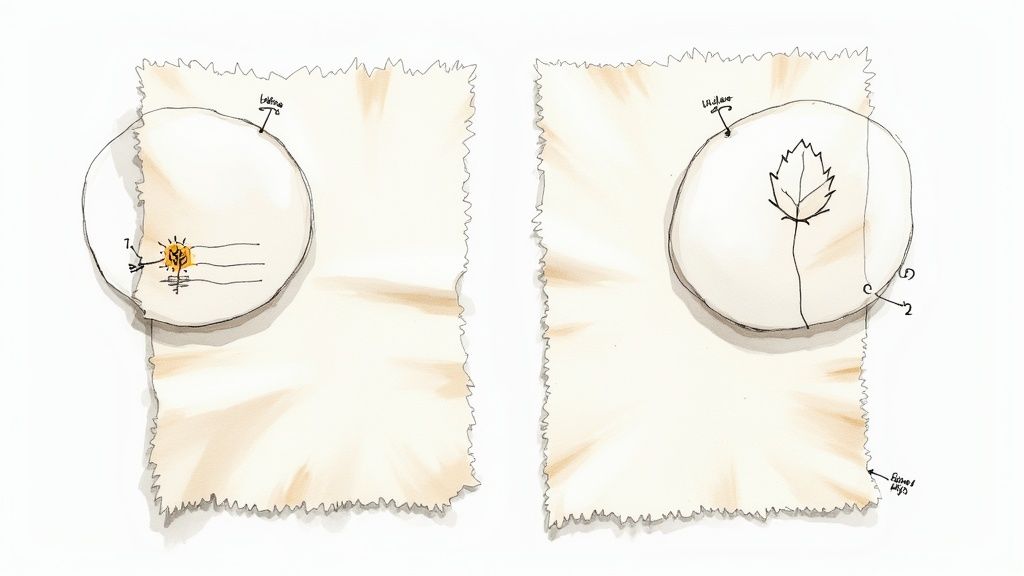
The journey from a cotton boll to the fabric in your home has a real impact on your wallet, your well-being, and even the feel of a t-shirt against your skin. This is where the debate between organic and conventional cotton moves from the farm to our daily lives. The choices made in the field create tangible differences in quality, price, and health.
Ever noticed how some cotton fabrics feel incredibly soft right away, while others feel a bit stiff? The difference is often in the fibers themselves. High-quality organic cotton tends to have longer, stronger, and smoother fibers. This isn't just a happy accident—it's the direct result of gentler farming and processing.
Conventional cotton farming often relies on harsh chemical treatments and bleaching agents. These can weaken the fibers, making them brittle and more likely to break down. Organic cotton, on the other hand, is usually hand-picked. This careful handling protects the integrity and length of the fibers, leading to a textile that feels noticeably softer and holds up better over time. Your organic cotton sheets are less likely to pill, and your towels won't thin out as quickly, which means they're often a smarter investment in the long run.
Understanding the Price Difference
Let's talk about the price tag. It’s no secret that organic cotton products usually cost more, and it's fair to ask why. The higher price isn't arbitrary; it reflects the real-world costs of producing cotton sustainably and ethically.
Several key factors contribute to this price premium:
- Certification Costs: Earning and keeping a certification like the Global Organic Textile Standard (GOTS) is a demanding and expensive process. It’s a guarantee of environmental and social responsibility from seed to shelf.
- Lower Yields: Organic farming doesn't use chemical boosters, so it often produces less cotton per acre. This naturally makes the raw material more expensive.
- Labor-Intensive Work: Things like weeding by hand and using natural pest controls require more people and more time than simply spraying a field with chemicals.
- Fair Wages: A cornerstone of many organic standards is ensuring farmers and workers are paid fairly and have safe working conditions. That commitment to people is factored into the final cost.
While you pay more upfront, many people see it as a worthwhile investment in a product that lasts longer, is better for their health, and supports a more responsible industry.
The price tag on organic cotton reflects a commitment to quality and ethics. You are paying for longer-lasting fabric, chemical-free processing, and a supply chain that respects both people and the planet.
Direct Health Benefits for You and Your Family
This is one of the most compelling reasons to choose organic. Conventional cotton is often processed with a cocktail of chemicals, from pesticides and insecticides in the field to formaldehyde resins and harsh dyes in the factory. Traces of these can linger in the finished fabric, sometimes leading to skin irritation, rashes, or allergic reactions.
If you or someone in your family has sensitive skin, eczema, or chemical sensitivities, this is a big deal. For babies and young children, whose skin is thinner and more absorbent, the difference is even more critical.
Organic cotton is naturally hypoallergenic because it’s grown and processed without these toxic chemicals. It’s clean, pure, and free from the harsh bleaches and softeners that can cause problems. This makes it a much safer choice for anything that spends a lot of time against your skin, like bedding, towels, and clothing.
Certifications can give you an extra layer of confidence. GOTS ensures the cotton was grown organically, while other labels confirm the final product is free of harmful substances. To understand more, you can learn about what it means for a textile to be OEKO-TEX certified in our detailed guide. By choosing certified organic, you’re effectively eliminating the risk of exposing your family to residual chemicals, making it the clear winner for anyone putting health first.
Making a Conscious Consumer Choice
When you're standing in the aisle, deciding between organic and conventional cotton, it’s not really a simple "good vs. bad" choice. It's about figuring out what matters most to you. Are you driven by environmental impact? Personal health? Or is budget the bottom line? The most practical approach is to think strategically about where organic cotton makes the biggest difference.
For many, this means prioritizing organic for items that spend the most time directly on our skin or for the most vulnerable people in our families. You don't have to overhaul your entire life overnight, but starting with those high-contact textiles is a smart and impactful way to begin.
Where to Prioritize Organic Cotton
Making a thoughtful choice is about strategy, not a rigid all-or-nothing mindset. Some products just give you more bang for your buck, so to speak, when you choose organic—especially the things you use every single day.
Here’s where I always suggest people start:
- Bedding and Towels: Think about it—you spend roughly a third of your life wrapped in sheets. Towels are used daily on your skin. Going organic here drastically cuts down your prolonged exposure to potential chemical residues. If you're looking for quality, some of the best organic cotton towels manage to be incredibly soft while giving you that peace of mind.
- Baby Clothes and Blankets: A baby's skin is far more delicate and porous than an adult's. This makes chemical-free, naturally hypoallergenic organic cotton the safest and kindest choice you can make for them.
- Undergarments and T-Shirts: For anything worn directly against your skin all day long, organic cotton is a game-changer. It helps minimize the risk of irritation from the residual dyes and finishing chemicals that are common in conventional fabrics.
By focusing on these key areas, you can maximize the health and comfort benefits for your family while making a positive environmental impact where it counts the most.
How to Identify Authentic Organic Products
So, how do you know you're actually getting the real deal? Always check the label for trusted certifications. The Global Organic Textile Standard (GOTS) is the one to look for. It's truly the gold standard in the industry.
A GOTS seal doesn't just mean the cotton was grown organically; it guarantees the entire process, from farm to finished product, was free from harmful chemicals and met strict social and environmental criteria. For a deeper dive, this comprehensive guide to organic cotton sheets offers some great insights into what these certifications really mean.
At the end of the day, every dollar you spend is a vote for the kind of world you want to live in. By making informed, practical choices in the organic vs. conventional cotton debate, you’re supporting a system that values the planet, the farmer, and your own well-being.
Cotton FAQs: Your Questions Answered
Even after comparing the two, you probably have a few more questions rattling around. Let's tackle some of the most common ones that come up when people are deciding between organic and conventional cotton.
Is Organic Cotton Really Softer?
Yes, in most cases, it absolutely is. The difference in softness often comes down to how the cotton is harvested. Organic cotton is typically hand-picked, which is a much gentler process that keeps the delicate fibers long and intact. Machine harvesting, common in conventional farming, can be rough, breaking and damaging the fibers before they even leave the field.
These longer, unbroken organic fibers can be spun into smoother, finer yarns. The result is a fabric that feels incredibly soft and luxurious against your skin. Plus, because organic cotton isn't treated with harsh chemicals and bleaches that make fibers brittle, it stays soft and resists pilling for much longer.
Why Is Organic Cotton More Expensive?
The higher price tag isn't just a marketing gimmick; it reflects the real-world costs of growing cotton sustainably and ethically. There are a few key reasons for the price difference:
- More Hands-On Labor: Weeding by hand and using natural pest control methods takes a lot more time and effort than simply spraying a field with chemicals.
- The Price of Certification: Getting and keeping a certification like the Global Organic Textile Standard (GOTS) is a significant investment for farmers and producers. These fees cover rigorous inspections and audits.
- Smaller Harvests: Organic farming techniques often result in lower yields per acre since they don't rely on synthetic fertilizers and growth enhancers. This makes the raw material itself more scarce and valuable.
- Fairer Wages: A big part of the organic and ethical movement is ensuring farmers and garment workers are paid a living wage and have safe working conditions. That commitment to people is built into the final cost.
While you pay more upfront, you're getting a product that’s built to last, making it a better value in the long run.
You can think of the price difference as a direct investment in healthier ecosystems, safer working conditions for farmers, and a chemical-free product for your home. It’s a vote for a more responsible textile industry.
Is All Non-GMO Cotton Considered Organic?
This is a great question, and the answer is no. It's a common mix-up. While all certified organic cotton must come from non-genetically modified seeds, the reverse isn't true. A farmer can easily plant non-GMO seeds but still douse their fields with synthetic pesticides and fertilizers.
The "organic" certification is about an entire ecosystem of practices. It’s a holistic approach that covers everything from the seed and soil health to water conservation and the complete absence of toxic chemicals all the way to the finished product. To be certain, you really need to look for those official organic certifications on the label.
At Anatolico, we believe the best textiles are beautiful, functional, and responsible. Our collection of Turkish towels, robes, and home goods is crafted from OEKO-TEX certified materials by master artisans, ensuring every piece is free from harmful substances and made with care. Experience the difference for yourself at https://www.anatolico.co.

